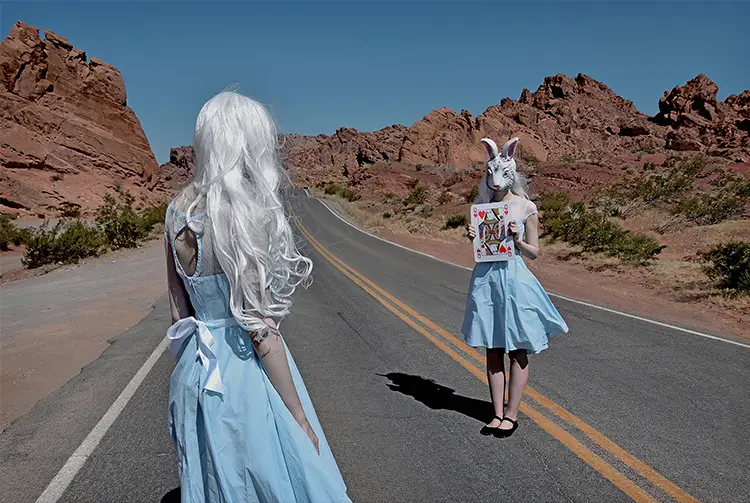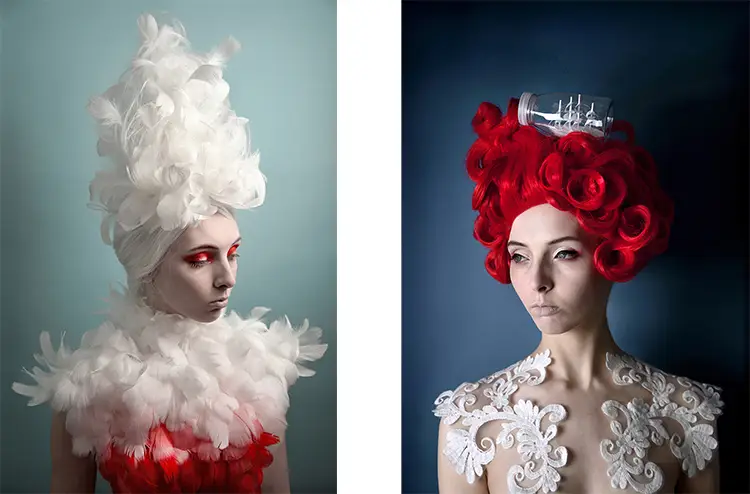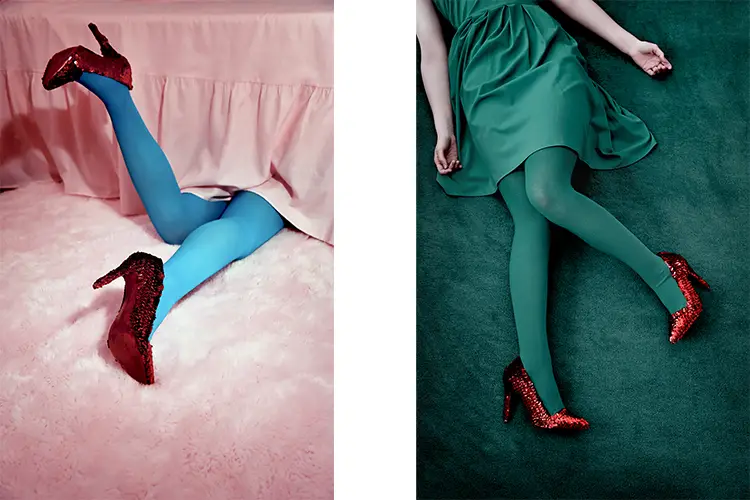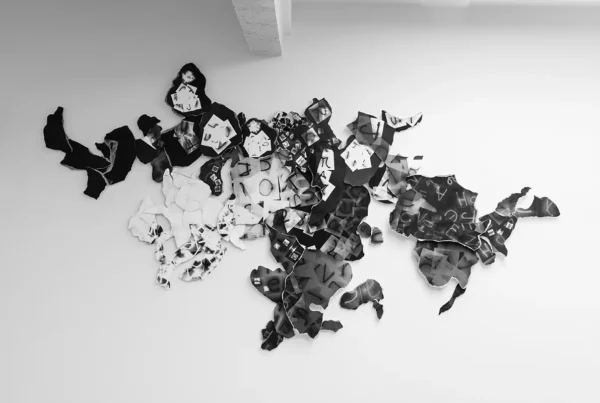“I believe in challenging myself with each series and I find I am always outside of my comfort zone, but I think this is the only way to learn and develop.”
The Storyteller’s Eye: Vicky Martin’s Path to Conceptual Photography
Vicky Martin stands as a compelling force in contemporary conceptual photography, known for weaving intricate stories through her vividly staged portraits. With a foundation in art and design, Martin’s creative practice is deeply informed by her diverse background, which includes studies in fashion and hands-on experience as an assistant designer. Her artistic journey began with black and white analogue photography, a medium that taught her the essentials of visual composition. However, her evolution into color photography and digital manipulation allowed her to unlock a new dimension of artistic freedom—one where hues and tones became as integral to narrative construction as the subjects themselves. Today, Martin’s photographs resonate with cinematic flair, merging the aesthetic sensibilities of studio portraiture with the spontaneity of on-location shoots.
Martin’s early fascination with fashion continues to echo throughout her body of work. Rather than relying solely on external costume designers or stylists, she often crafts the props and garments that populate her visual worlds. This hands-on approach not only deepens the authenticity of her imagery but also enables her to blur the lines between fashion, sculpture, and photography. Whether channeling the opulence of historical periods or conjuring fantastical, whimsical aesthetics, Martin’s costuming choices amplify the narrative intensity of her portraits. Each element within her frame serves a purpose, contributing to the layered storytelling that has become her signature.
Driven by a desire to move beyond surface beauty, Martin’s work consistently explores deeper psychological landscapes. Her portraits are not mere representations of subjects but rather explorations of identity, power, and vulnerability. This narrative-rich approach has positioned her as an artist who refuses to shy away from complex themes. Instead, she embraces them fully, challenging herself to step outside her creative comfort zone with each new series. For Martin, discomfort is not an obstacle but a necessary catalyst for growth, pushing her artistry forward and continually reshaping her visual language.

Vicky Martin: Navigating Identity, Femininity, and the Power of Visual Storytelling
Central to Vicky Martin’s artistic vision is a profound exploration of the female experience—an inquiry that informs both the aesthetic and thematic underpinnings of her work. Her conceptual portraits often wrestle with questions of identity, self-perception, and the societal constructs that define womanhood. Rather than adhering to traditional portrayals of femininity, Martin interrogates the expectations imposed on women, spotlighting the tensions between personal agency and cultural prescriptions. Through carefully composed images, she captures the fragile balance between strength and vulnerability, illustrating how these opposing forces coexist within the same narrative space.
This ongoing investigation of gender constructs manifests through recurring motifs and symbolic choices throughout Martin’s series. Her use of color, costume, and setting often speaks directly to the dichotomy between individual identity and collective ideals. Whether referencing fairytale tropes or cinematic archetypes, Martin’s images challenge viewers to reconsider the ways in which femininity is both celebrated and constrained. The psychological depth of her work invites reflection on how narratives of womanhood are shaped—not just by history and media, but by the internal struggles of those who inhabit these identities.
At the heart of Martin’s storytelling is a refusal to offer simplistic interpretations. Her portraits resist easy categorization, instead presenting multifaceted characters who embody contradictions and complexities. By emphasizing narrative ambiguity, she encourages audiences to engage critically with the imagery and the ideas it provokes. This approach not only enhances the emotional resonance of her photography but also solidifies her commitment to using art as a means of dialogue—one that acknowledges the layered realities of women’s lives across time and culture.

Between Fantasy and Reality: Inspirations That Shape Vicky Martin’s Vision
Vicky Martin’s creative universe is deeply influenced by powerful female characters and the literary and cinematic worlds they inhabit. These figures—whether from children’s literature or cult classic films—serve as enduring muses, their stories growing richer and more nuanced as Martin reinterprets their symbolism through her own artistic lens. Characters from The Wizard of Oz and Alice in Wonderland frequently surface in her work, embodying the duality of innocence and rebellion, fantasy and disillusionment. Martin’s attraction to such narratives reflects her fascination with the intersection of childhood imagination and adult reflection, a space where symbolic meaning continually evolves.
Beyond literature, the dreamlike aesthetic of David Lynch’s films and the glamour of Hollywood’s golden era also inform Martin’s photographic language. These influences offer a visual shorthand for exploring tension, surrealism, and emotional undercurrents. Lynch’s signature blend of beauty and unease finds echoes in Martin’s own compositions, where elegance often conceals deeper psychological struggles. Similarly, the allure and artificiality of classic Hollywood imagery become tools for Martin to critique and deconstruct idealized femininity, using nostalgia as both inspiration and interrogation.
What unites these varied influences is Martin’s keen interest in the friction between fantasy and reality—a thematic thread that runs consistently through her portfolio. By drawing from stories that blur these boundaries, she creates portraits that feel simultaneously familiar and unsettling. This dynamic interplay allows her work to operate on multiple levels, inviting viewers to navigate both the surface aesthetics and the symbolic meanings embedded within each image. Through this synthesis of inspiration, Martin continues to expand her artistic vocabulary, ensuring that each project resonates with emotional depth and conceptual rigor.

Vicky Martin: Pushing Boundaries and Realizing Artistic Dreams
Among Vicky Martin’s body of work, the series Curiouser and Curiouser holds particular personal and professional significance. This project marked a pivotal moment in her artistic development, representing a leap forward in both technical execution and conceptual ambition. Shot on location under tight time constraints, the series challenged Martin to embrace composite imaging for the first time—an approach that unlocked new creative possibilities and expanded her visual storytelling techniques. The successful realization of this project not only validated her artistic instincts but also emboldened her to continue pushing the limits of her craft in subsequent series.
Building on the momentum of Curiouser and Curiouser, Martin has continued to pursue ambitious narratives that demand complex production processes and thoughtful conceptualization. Her commitment to growth is evident in each new body of work, where she consistently seeks out challenges that force her outside familiar territory. This philosophy of continual experimentation ensures that her voice as an artist remains dynamic, evolving in response to both personal introspection and external cultural dialogues. Rather than repeating past successes, Martin views each project as an opportunity to deepen her exploration of visual narrative and thematic inquiry.
Currently, Martin is immersed in the production of her latest series, The Invisible Woman, a project that has been years in the making. Conceived in 2019 and finally brought to life in 2024, this series was shot in Los Angeles, utilizing iconic locations that Martin once considered out of reach. The realization of this long-gestating dream reflects her determination and patience, as well as her unwavering commitment to artistic integrity. Through The Invisible Woman, Martin continues to confront themes of visibility, identity, and self-perception—extending her exploration of the female experience while breaking new ground in her creative journey.






